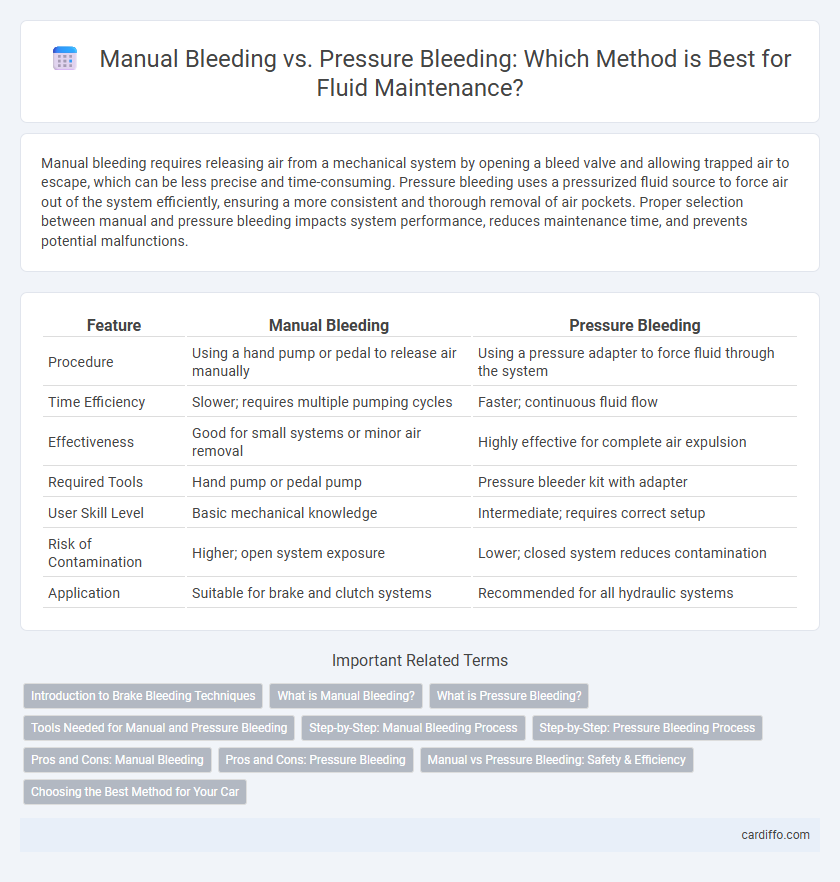Manual bleeding requires releasing air from a mechanical system by opening a bleed valve and allowing trapped air to escape, which can be less precise and time-consuming. Pressure bleeding uses a pressurized fluid source to force air out of the system efficiently, ensuring a more consistent and thorough removal of air pockets. Proper selection between manual and pressure bleeding impacts system performance, reduces maintenance time, and prevents potential malfunctions.
Table of Comparison
| Feature | Manual Bleeding | Pressure Bleeding |
|---|---|---|
| Procedure | Using a hand pump or pedal to release air manually | Using a pressure adapter to force fluid through the system |
| Time Efficiency | Slower; requires multiple pumping cycles | Faster; continuous fluid flow |
| Effectiveness | Good for small systems or minor air removal | Highly effective for complete air expulsion |
| Required Tools | Hand pump or pedal pump | Pressure bleeder kit with adapter |
| User Skill Level | Basic mechanical knowledge | Intermediate; requires correct setup |
| Risk of Contamination | Higher; open system exposure | Lower; closed system reduces contamination |
| Application | Suitable for brake and clutch systems | Recommended for all hydraulic systems |
Introduction to Brake Bleeding Techniques
Brake bleeding techniques are essential for maintaining hydraulic brake systems by removing air bubbles that impair braking efficiency. Manual bleeding involves a technician manually pumping the brake pedal while opening the bleed valve, ensuring air is expelled incrementally. Pressure bleeding uses a pressurized device to force brake fluid through the system, offering a faster and more consistent method to eliminate trapped air effectively.
What is Manual Bleeding?
Manual bleeding is a maintenance process used to remove air bubbles from hydraulic brake systems by manually depressing the brake lever or pedal to expel trapped air. This technique requires assistance, as one person pumps the brake while another opens and closes the bleeder valve to release air and brake fluid. Manual bleeding helps restore brake responsiveness and safety by ensuring an air-free hydraulic circuit.
What is Pressure Bleeding?
Pressure bleeding is a method of removing air from hydraulic brake systems by applying consistent pressure through a specialized tool or the vehicle's own system while opening the bleeder valves. This technique ensures a more efficient and thorough removal of air pockets compared to manual bleeding, reducing the risk of spongy brake pedal feel and improving braking performance. It is commonly used in automotive maintenance for precise brake system servicing, especially in ABS-equipped vehicles.
Tools Needed for Manual and Pressure Bleeding
Manual bleeding requires basic tools such as a wrench, clear tubing, and a container to catch expelled fluid, making it accessible for most home mechanics. Pressure bleeding utilizes a specialized pressure bleeder kit, which includes a pressurized fluid reservoir and adapter fittings to ensure a consistent flow and reduce air bubbles in the hydraulic system. Proper tools directly impact the efficiency and effectiveness of brake fluid bleeding in automotive maintenance.
Step-by-Step: Manual Bleeding Process
Manual bleeding involves opening the bleed valve to release trapped air, allowing fluid to flow until no air bubbles appear, ensuring effective brake system performance. The step-by-step process begins by securing the brake fluid reservoir cap, attaching a clear tube to the bleed nipple, and slowly pressing the brake pedal while opening the nipple to expel air. Repeating this cycle until a steady stream of fluid emerges confirms complete air removal and optimal hydraulic pressure.
Step-by-Step: Pressure Bleeding Process
Pressure bleeding involves attaching a pressurized reservoir filled with brake fluid to the master cylinder to force fluid through the brake lines, effectively removing air bubbles. First, secure the pressure bleeder to the master cylinder reservoir and pressurize it to the recommended PSI, typically between 15-20 PSI. Open each bleeder valve in sequence, starting from the wheel farthest from the master cylinder, until clear fluid flows without air bubbles, then close the valves and release pressure before final checks.
Pros and Cons: Manual Bleeding
Manual bleeding offers a straightforward and cost-effective method for removing air from hydraulic or cooling systems, requiring only basic tools and minimal technical expertise. However, it can be time-consuming and prone to incomplete air removal, potentially resulting in system inefficiencies or overheating. This method also demands careful monitoring to avoid introducing contaminants or causing fluid spills.
Pros and Cons: Pressure Bleeding
Pressure bleeding offers the advantage of reducing air bubbles more efficiently from brake lines compared to manual bleeding, enhancing brake responsiveness and safety. It requires specialized equipment and may be more time-consuming or costly upfront, but ensures consistent pressure application for better fluid circulation. The method minimizes the risk of introducing new air during the process, making it ideal for advanced brake maintenance and high-performance vehicles.
Manual vs Pressure Bleeding: Safety & Efficiency
Manual bleeding requires operators to open valves slowly, exposing them to potential fluid spray, whereas pressure bleeding uses system pressure to push air out, significantly reducing safety risks. Pressure bleeding offers higher efficiency by speeding up the process and ensuring more complete air removal compared to the slower, more labor-intensive manual method. Hydraulic and brake maintenance benefit from pressure bleeding's consistent pressure application, enhancing system reliability and operational safety.
Choosing the Best Method for Your Car
Manual bleeding allows precise control over brake fluid flow, making it ideal for small-scale repairs or home mechanics with basic tools. Pressure bleeding offers faster, more efficient removal of air from brake lines, preferred in professional settings or for vehicles with ABS and complex brake systems. Evaluating your vehicle type, available equipment, and maintenance experience helps determine the best bleeding method for optimal brake performance.
Manual Bleeding vs Pressure Bleeding Infographic

 cardiffo.com
cardiffo.com